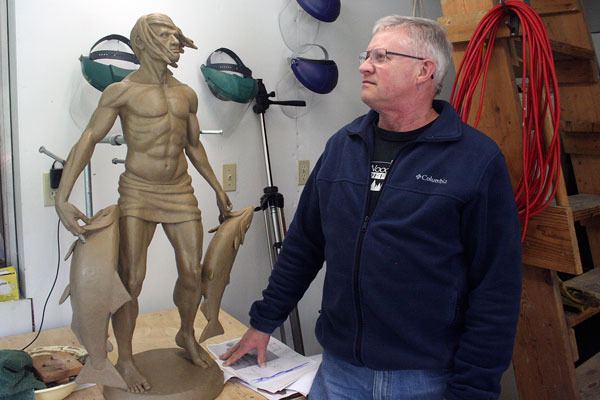It’s taken a couple of years of negotiating, but North Whidbey artist Wayne Lewis may soon send his 3-foot clay sculpture of a Native American to be cast in bronze.
Lewis is donating the intricately detailed sculpture, named “Island Spirit,” to the city of Oak Harbor for display on Pioneer Way.
He’s asking the city to foot the $6,500 bill for casting.
He also has another gift for the city up his sleeve: He’s working on a sculpture of the Barringtons, a couple who were among the earliest pioneers in Oak Harbor.
“I’m really interested in Whidbey Island history,” Lewis said.
“I live here and I think people would really like to see these sculptures,” he added. “It’s my community service. It’s what I do.”
Lewis’ statues will likely join other high-profile art pieces that have graced downtown since the renovation project on Southeast Pioneer Way was completed.
The city’s Arts Commission directed the purchase of three pieces — the bronze Stumbly Ducklings and mermaid and the silvery Moon Waves — over the last couple of years at a cost of $30,000 each.
During a recent City Council workshop, Senior Planner Cac Kamak said that the Arts Commission hopes to purchase an “eye-catching” piece for the entrance of the downtown area. He said the members plan to work with one of the artists who’ve already created downtown artwork.
The estimated $30,000 is available in the Arts Commission budget.
Kamak also informed the council members about Lewis’ sculpture of an Indian, which he said will be placed across the street from the mermaid statue. They were excited about the bronze artwork, but one councilman said they wished it was full-sized to match the mermaid.
Lewis, known for creating the bronze Dutch Boy at Windjammer Park, said he decided to make a sculpture honoring the native people of Whidbey Island. It features a muscular Indian man holding a salmon in each hand.
If everything goes as planned, the statue will be installed near the site of an Indian burial ground unearthed during the construction work on Pioneer Way.
Lewis said he strives for accuracy in his artwork. His idea was to depict a Native American fisherman the way he may have looked after catching fish 400 years ago in what is now Oak Harbor.
“They just went in the water and got salmon by hand.”
“There were so many of them,” he said.
Lewis first created a metal skeleton and affixed muscles before forming the clay skin.
He originally depicted the well-muscled Indian man wearing a loin cloth, but officials at the Swinomish tribe said they believed that was inaccurate.
“They felt it looked too much like a plains Indian,” he said.
Native Americans likely caught fish without clothes, but Lewis said a nude might not be appropriate for downtown Oak Harbor. So he settled on a more generic covering.
Lewis said he communicated with tribal officials over the past couple of years and has a letter stating their approval of the sculpture.
The chairman of the Swinomish Tribal Community examined it at Lewis’ studio.
Lewis also received approval from the Arts Commission. Next step is to get permission from the City Council.
Lewis will send his clay sculpture to a foundry in Oregon, where it will be cast in bronze using the lost wax method.
Ron Van Dam of Concrete Nor’West offered to donate a concrete pedestal for the sculpture.
Lewis is currently working with Whidbey historian Peggy Darst Townsdin on a sculpture of her great-great-grandparents, Capt. Edward Barrington and his wife, Christina. He’s basing it on their wedding photo, which he has blown up on the wall of his studio.
Capt. Barrington built the first store and pier in Oak Harbor circa 1855, Darst Townsdin wrote in a 2010 article for the News-Times.
Lewis said he plans to give the sculpture of the Barringtons to the city and hopes it is installed near the site of their store, which once stood near Mi Pueblo restaurant.



